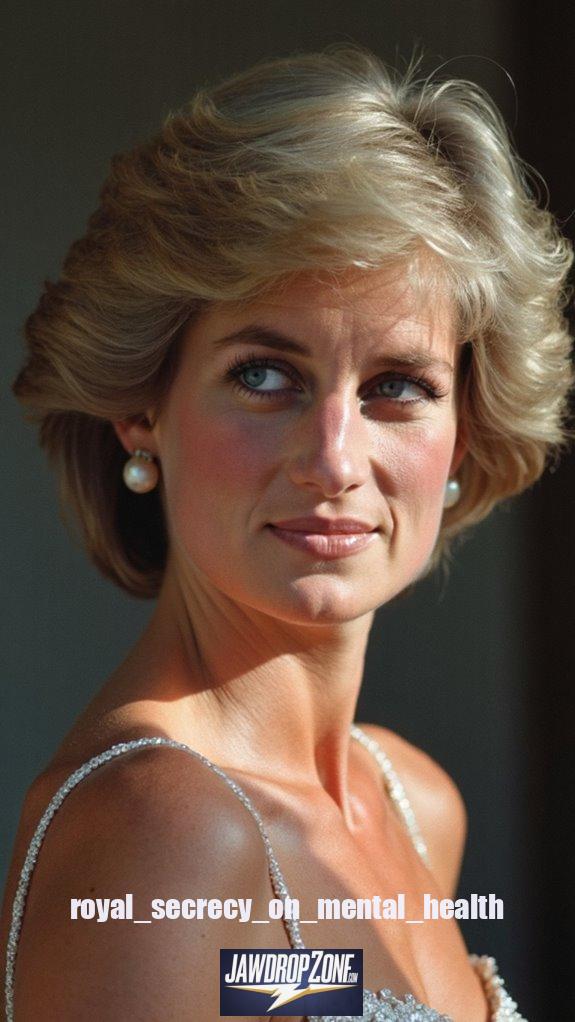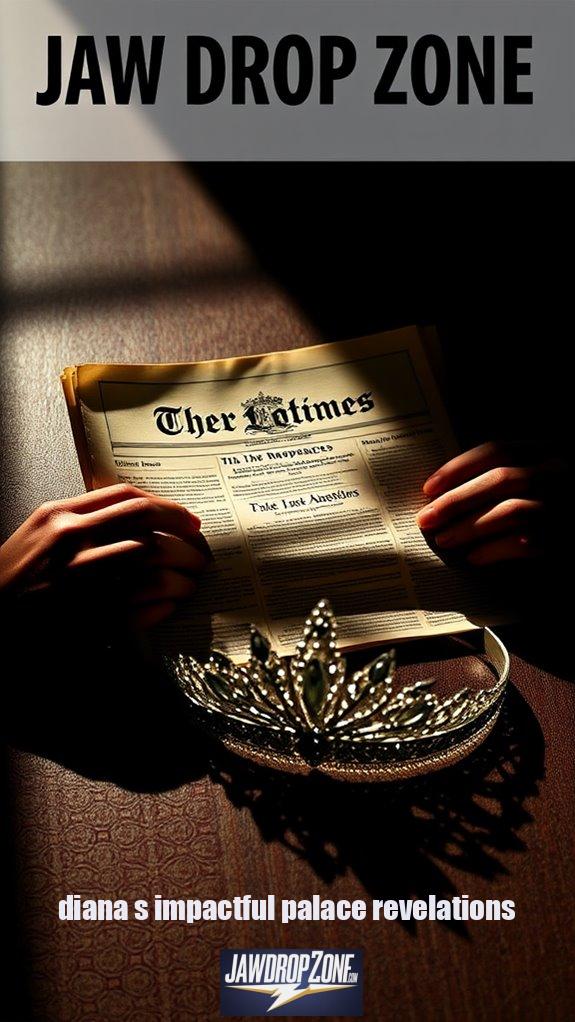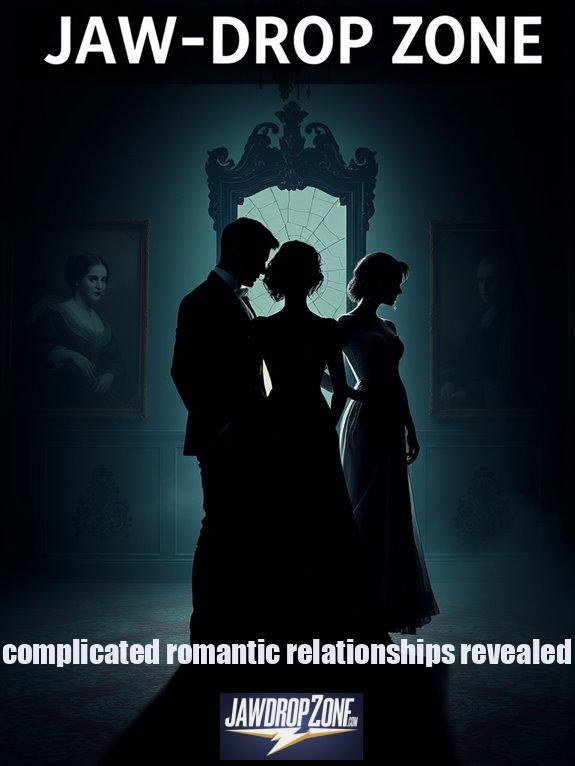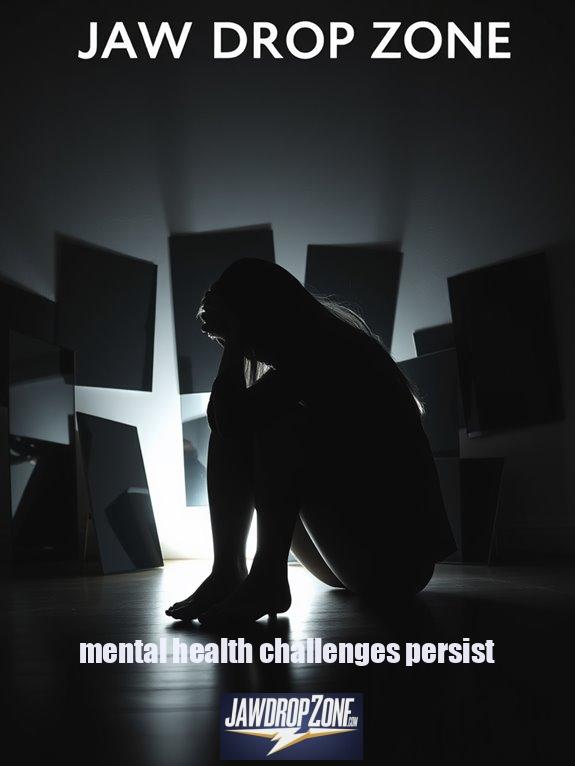The British Crown hid mental health issues to protect its public image and uphold traditions of secrecy. For example, they downplayed King George VI’s lung cancer as “structural abnormalities” and concealed Princess Diana’s bulimia and depression to avoid societal stigma and hereditary concerns. This maintained the monarchy’s perceived strength and stability. Exploring these examples further uncovers deeper understandings into royal history.
Historical Secrecy in the Royal Family

The royal family has long guarded their privacy, especially around health issues, to maintain a sense of tradition.
In historical backdrop, royal privacy meant keeping serious illnesses hidden from the public, shaped by cultural norms. For instance, King George VI’s lung cancer in the 1950s was described as “structural abnormalities” to avoid alarm and preserve dignity. This secrecy reflected societal expectations that valued discretion over openness.
Less severe cases, like Queen Elizabeth, the Queen Mother’s choking incident, saw selective disclosure, balancing privacy with public reassurance. A stark example of this secrecy is seen in the institutionalization of the Bowes-Lyon sisters, who were placed in a hospital due to their mental health conditions and kept away from public scrutiny.
Protecting the Monarchy’s Public Image

Secrecy shields the British monarchy’s public image from harm, carefully guarding the monarch’s reputation against potential damage. Health confidentiality has long been a tradition, helping to avoid stigma and maintain a sense of stability for the public. For instance, the royals use strategic PR to manage perceptions, selectively disclosing details while crafting official statements that protect family privacy. This approach minimizes media scrutiny, ensuring control over narratives and preserving power dynamics. By balancing public interest with personal boundaries, the monarchy fosters a secure, enduring legacy, reassuring people that their institutions remain strong and reliable. In this way, secrecy supports a protected image, allowing the family to navigate challenges without undue exposure. However, this tradition is evolving, as Prince William has been vocal about mental health importance to promote greater transparency in the modern era. This evolution mirrors the resilient journey of individuals who have overcome adversity, reflecting a broader cultural shift towards acknowledging emotional well-being.
Diana’s Mental Health Challenges and Cover-Up

While Diana grappled with bulimia and postpartum depression, the royal family often concealed her struggles to protect their image.
Diana’s struggles included self-injury, mood swings, and ongoing depression, which the royal silence made worse. Additionally, her fourth attempt at suicide exemplified the extent of her desperation that was deliberately downplayed by the institution. The institution ignored these issues, prioritizing a perfect public facade that added immense pressure.
Diana’s struggles with self-injury, mood swings, and depression worsened under royal silence, as the institution favored a flawless public image over support.
For instance, during her marriage problems, limited support left her isolated under constant scrutiny. This cover-up meant her emotional challenges went unaddressed, as the family minimized discussions to maintain privacy.
Yet, Diana’s openness later helped others, though at the time, royal silence deepened her pain. By hiding these realities, the Crown missed chances to offer real help, underscoring the need for empathy in such situations.
Societal Stigma and Hereditary Concerns

Throughout history, mental illness has sparked deep stigma, especially in royal families, where it was seen as a shameful weakness. Royals actively hid these issues to meet societal expectations of strength and stability. For instance, they feared hereditary mental illness might harm heirs’ legitimacy, so families concealed conditions to protect their lineage. This secrecy stemmed from societal expectations that demanded royals embody moral superiority, suppressing any signs of vulnerability. Notably, many imprisoned queens, such as Mary, Queen of Scots, faced similar pressures, as their mental health struggles were often dismissed or hidden to maintain the perceived image of strength. Discrimination and prejudice made open discussions risky, as it could lead to public scandal or exclusion. Today, growing awareness helps reduce these fears, encouraging safer, more empathetic approaches to mental health support, and Prince Harry’s journey serves as a modern example of overcoming such stigma through openness and advocacy.
Questions and Answers
How Has Royal Mental Health Policy Evolved Today?
Royal mental health policy has evolved from historical mental health approaches, such as asylums and community reforms, to focus on modern royal initiatives.
Today, royals actively support awareness campaigns and foundations that emphasize early intervention and stigma reduction. For instance, they back programs providing community resources, ensuring safer, empathetic care for individuals.
This shift promotes prevention and recovery, blending past lessons with current efforts.
What Personal Impacts Did Cover-Ups Have on Family?
Out of sight, out of mind, cover-ups in family dynamics often deepened personal wounds.
The royal family’s secrecy, like ignoring Nerissa and Katherine Bowes-Lyon, amplified stigma effects, leading to isolation and neglect.
This treatment, as if the sisters didn’t exist, caused emotional pain for relatives, fostering long-term disconnection and regret, while hindering open support and healing.
Families faced strained relationships, underscoring the need for transparency.
Are There Similar Cover-Ups in Other Monarchies?
Other monarchies often hide mental health issues, protecting royal secrets and battling monarchy stigma.
For example, the Saudi royal family conceals health problems to maintain control, while Asian monarchies keep details private amid intense scrutiny.
European royals face similar accusations, perpetuating societal stigma and limiting support for individuals.
These practices foster distrust if truths emerge, echoing broader patterns of secrecy.
How Did the Crown Affect Public Mental Health Views?
The Crown reshaped public perception of mental health by tackling royal stigma head-on.
It portrayed characters like Princess Diana facing vulnerabilities, fostering empathy and reducing stigma. This encouraged open discussions, educating viewers on historical attitudes.
As a result, the show shifted societal views, promoting awareness and support for mental health challenges worldwide.
What Modern Laws Address Hereditary Mental Disorders?
Modern laws address hereditary mental disorders through key legal reforms that protect individuals from discrimination.
For example, the Genetic Information Nondiscrimination Act prevents employers and insurers from using hereditary conditions against people. Courts increasingly accept genetic evidence, balancing it with environmental factors for fair trials.
These changes promote safety, empathy, and access to genetic counseling, ensuring responsible handling of mental health risks. Reforms continue to evolve, supporting affected families.
References
- https://en.wikipedia.org/wiki/Nerissa_and_Katherine_Bowes-Lyon
- https://www.esquire.com/entertainment/tv/a34728377/queen-elizabeth-cousins-katherine-nerissa-bowes-lyon-asylum-true-story-the-crown-season-4/
- https://www.scmp.com/magazines/style/celebrity/article/3167561/truth-behind-queen-elizabeths-hidden-cousins-who-were
- https://people.com/royals/the-crown-queen-elizabeth-cousins-secretly-lived-in-psychiatric-hospital/
- https://www.grunge.com/1545380/serious-health-problems-royal-family-tried-to-hide/
- https://time.com/6836402/kate-middleton-health-royal-family-history/
- https://time.com/6958485/kate-middleton-king-charles-health/
- https://www.hrp.org.uk/blog/the-kings-malady-george-iiis-mental-illness-explored/
- https://ps.psychiatryonline.org/doi/full/10.1176/appi.ps.51.2.259
- https://www.theroyalobserver.com/p/princess-dianas-mental-health-struggles-nearly-destroyed-her
- https://time.com/4918729/princess-diana-mental-health-legacy/
- https://www.amenclinics.com/blog/what-the-crown-got-wrong-about-princess-diana-and-eating-disorders/
- https://timesofindia.indiatimes.com/life-style/health-fitness/de-stress/how-princess-diana-sparked-conversations-around-mental-health/articleshow/86964302.cms
- https://www.newenglandrecoverycenter.org/blog/prince-harry-on-mental-health-addiction-and-ending-the-stigma/
- https://historyandpolicy.org/opinion-articles/articles/prince-harry-and-the-history-of-mental-health-stigma-policy/
- https://royalfoundation.com/mental-health/
- https://www.menningerclinic.org/news-resources/bloggers-confront-the-stigma-of-mental-illness
- https://www.newportacademy.com/resources/mental-health/royal-family/
- https://www.healthaffairs.org/doi/10.1377/hlthaff.17.4.239
- https://grantome.com/grant/NIH/R01-MH039030-03







